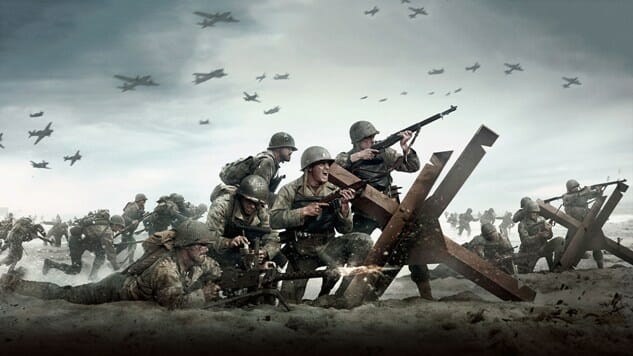Defusing D-Day: How Call of Duty: WWII Undermines What Should Be Its Most Powerful Moment
Games Features Call of Duty: WWII
I didn’t really play first-person shooters until 2002’s Medal of Honor: Frontline. What appealed to me about that game wasn’t just its historical setting, which resonated with me far greater than shotgunning demons in Hell or chasing disfigured polygonal versions of James Bond enemies, but the chaotic power of its opening D-Day beach-storming scene. It captured the fear, bravery and savagery of the infamous sequence from Saving Private Ryan to an extent that I didn’t think was possible with games at the time. It was harrowing in a way no fictional videogame scenario could be, and more somber and serious than the other shooters of its era. It’s been 15 years and I still think about that scene whenever I start up a new military shooter.
Call of Duty: WWII, which came out last Friday, and returns the series to World War II for the first time in almost a decade, also starts its single-player campaign with the Normandy invasion. 15 years of technological improvements make this scene look and sound more lifelike than Frontline’s, with graphic depictions of injured servicemen across the beach and the vivid boom of gunfire and explosions. Despite that bombast, the scene doesn’t come close to matching Frontline’s impact.
Part of it is that you can’t really capture that moment twice. Frontline was the first game to present a first-person recreation of D-Day, and any subsequent attempts will always wind up being compared to it. There’s something deeper here, though, that hinges on some of the decisions Sledgehammer Games made about WWII’s story. By introducing us to its cast of characters before D-Day, WWII strips away the faceless universality of Frontline and Saving Private Ryan.
War shouldn’t be glamorized. Even when it might be just it’s still terrible and inhumane. But D-Day represents not just the turning point in the European theater of World War II, but an act of great sacrifice by normal young men who marched headfirst into sheets of bullets in hopes of liberating a continent most of them had no relationship with. By not introducing us to its characters until after the deadliest moments of the invasion, Saving Private Ryan and Frontline reinforced the scope and depth of that sacrifice. They don’t ask us to mourn specific characters, but every person who lost their life that day. Like the Tomb of the Unknown Soldier, an enduring symbol of sacrifice, that facelessness makes the carnage both more universal and more personal, the loss of life both more senseless and more significant.
Perhaps Sledgehammer wanted to avoid comparisons to Frontline or Saving Private Ryan as much as possible, but WWII begins with a scene that introduces the player’s character and five of his squad mates. It’s a glimpse of down time while on the boat to Normandy—they’re playing cards and making a bet involving the knife game—and it immediately establishes that WWII will pull straight from the clichéd war film playbook for its characters. There’s the proud Texan, the mouthy scrapper from up north, the sensitive artistic one with glasses, the battle-hardened sergeant who’s always angry and disapproving because he’s already seen too many young lives lost in this war. It’s a collection of stock types that the game barely tries to develop before rushing them onto the beach. It’s impossible to feel any connection with them at this point, but they’re the primary focus of this particular D-Day, so there’s less drama to the scene than there should be. Instead of nameless stand-ins for every soldier who died that day, people who could be our neighbors and grandparents, WWII tries to transfer the weight of this pivotal moment in history to characters that it gives us little reason to care about.
WWII’s story gradually begins to recover from this initial misstep. It gives us greater insight into a few of these soldiers, making us care more about them as they liberate France. It never entirely escapes the trappings of its genre, but at least it does more overall to provide context and character than Medal of Honor: Frontline wound up doing. Still, nothing in the rest of Call of Duty: WWII is as memorable as its opening D-Day scene, which is a disappointment compared to what it could have been.
Garrett Martin edits Paste’s games and comedy sections. He’s on Twitter @grmartin.